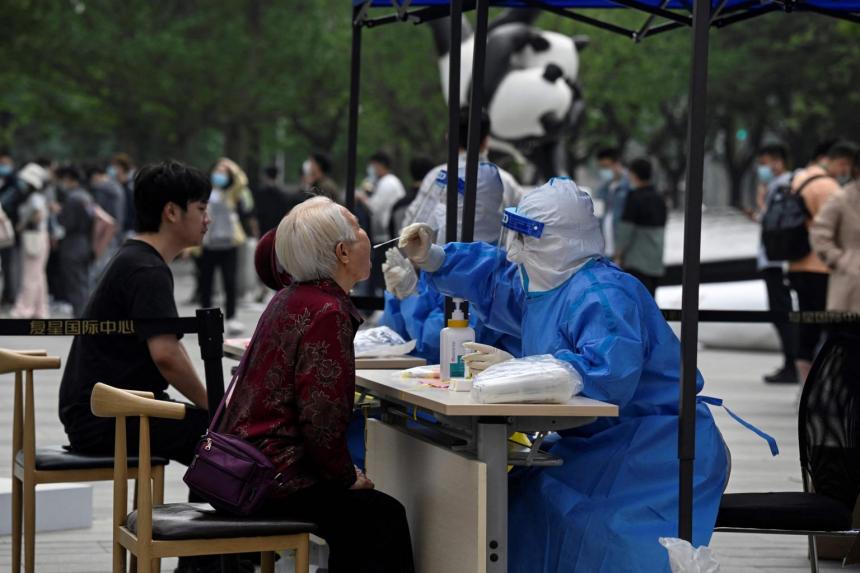LONDON (BLOOMBERG, NYTIMES) – China’s stringent rules to curb Covid-19 are about to unleash another wave of summer chaos on supply chains between Asia, the United States and Europe that is fuelling inflation worldwide.
Beijing on Tuesday (April 26) launched mass coronavirus testing for nearly all its 21 million residents, as fears grew that the Chinese capital may be placed under a strict lockdown. Shanghai, a major port and business centre, has been locked down for roughly a month, part of China’s zero-Covid-19 strategy. Other Chinese cities both large and small have announced their own restrictions on the movement of residents in a bid to keep the virus from spreading.
Beijing’s zero-tolerance approach amid an escalating Covid-19 outbreak brings the pandemic full circle, more than two years after its emergence in Wuhan upended the global economy. Shipping congestion at Chinese ports, combined with Russia’s war in Ukraine, risks a one-two punch that threatens to derail the global recovery, already buffeted by inflation pressures and headwinds to growth.
Even if the virus is reined in, the disruptions will ripple globally – and extend through the year – as bunched-up cargo vessels start sailing again.
“We expect a bigger mess than last year,” said Mr Jacques Vandermeiren, the chief executive officer of the Port of Antwerp, Europe’s second-busiest for container volume, in an interview. “It will have a negative impact, and a big negative impact, for the whole of 2022.”
China accounts for about 12 per cent of global trade and Covid-19 restrictions have idled factories and warehouses, slowed truck deliveries and exacerbated container logjams. US and European ports are already swamped, leaving them vulnerable to additional shocks.
“Once product export activities resume and a large volume of vessels make their way to the US West Coast ports, we expect waiting times to increase significantly,” said Ms Julie Gerdeman, CEO of supply chain risk analytics firm Everstream Analytics.
In the short run, the pile-ups will mean more costly headaches in the US$22 trillion (S$30 trillion) arena for global merchandise trade, which slumped in 2020 and rebounded last year. In the longer term, such chaos is redrawing the contours of a global economy tied together by cross-border commerce. For some corporate executives, reeling in far-flung production networks is no longer a patriotic political slogan – it is a business necessity given all the uncertainty.
“This has accelerated the pressing need for supply chains to become more regional,” Mr Lorenzo Berho, CEO of Vesta, a Mexican developer of industrial buildings and distribution centres, said on a conference call last week. The shift towards shorter supply chains to places like Mexico is under way to reduce exposure to Asia.
Said Mr Berho: “Globalisation, as we know it, may be coming to its end.”
Key policymakers are coming round to the idea that a sea change in the developed world’s supply lines is necessary. US Treasury Secretary Janet Yellen calls her idea for more resilient trade linkages “friend-shoring” – a not-so subtle jab at China and Russia. Much of the shift hinges on whether the pandemic has convinced consumers to accept higher prices for products made closer to home, and at least one consultant’s analysis says they are.
Companies have weathered the roughest bouts of supply turmoil over the past year partly by raising prices – and consumers have largely absorbed the hit. In the near term, though, supplies from China pose a more menacing cloud than the questions about household demand.
Tesla lost about a month of work during the Shanghai shutdown. Retailer Bed Bath & Beyond earlier this month said an “abnormally high” level of inventory was in transit, unavailable or held at ports throughout the early part of this quarter. Alcoa, the aluminium giant that is a bellwether for the global economy, last week blamed transport snarls for higher inventories. Continental, Europe’s second-largest maker of car parts, lowered its growth forecast for global production of passenger cars and light commercial vehicles to a range of 4 per cent to 6 per cent, from 6 per cent to 9 per cent previously.


